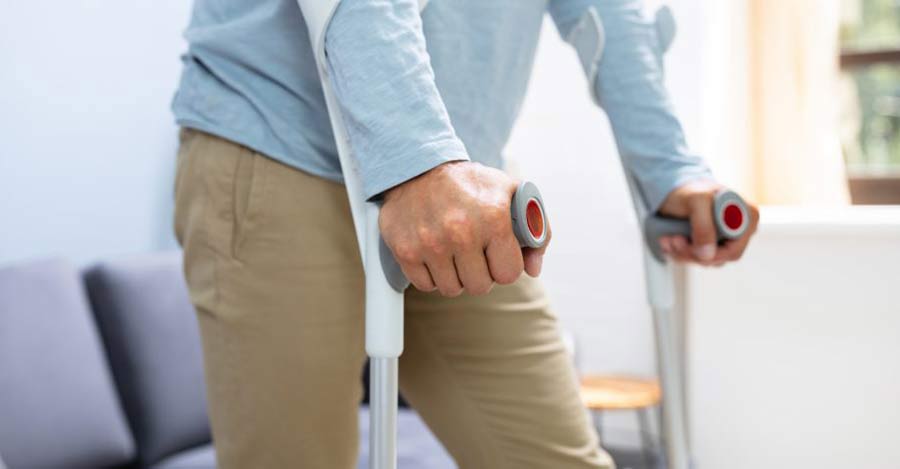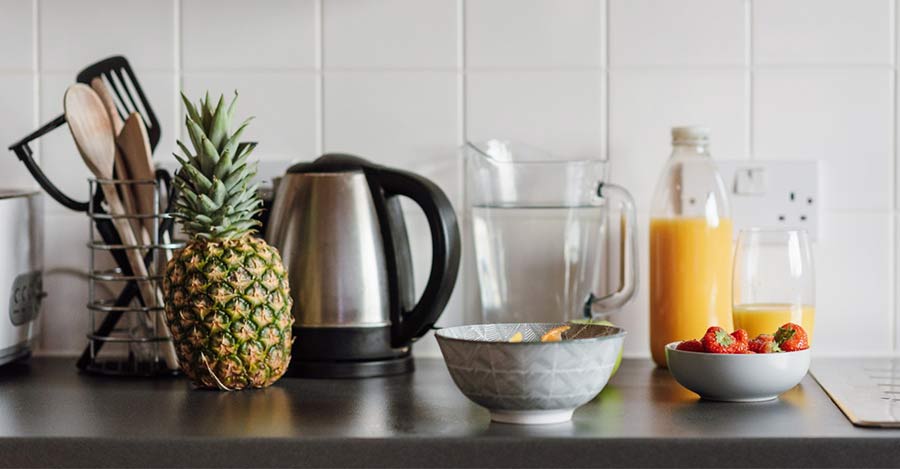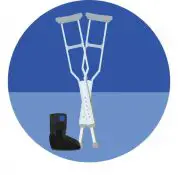10 Tips to easy life at home on crutches
- Last Update:
Surviving at home with crutches isn’t as challenging as it sounds. Many people can cope with using crutches in the short term or long term in their homes if they follow a few tips. To help you learn how to survive at home with crutches, we have provided ten tips you should consider.
1. Reorganize Your Living Space
Arguably, one of the very first things you should do after you learn that you need to use crutches is reorganize your living space. You need to make sure all corridors and areas that you will be using are uncluttered and organized. You don’t want to use crutches to get around your home and suffer an injury because you fell over objects.
Additionally, you should consider leaving all doors open in your home. When you are using crutches, it is hard to open doors. Rather leave them open as you will be less likely to cause yourself harm by doing so.
Kitchen
No matter the size of your house’s kitchen, you need to ensure all the things you use daily are within easy access. This could mean removing or leaving open cupboard doors. Or it could mean leaving certain items on top of reachable counters. You also shouldn’t forget about moving things from low cupboards. You won’t be able to reach items stored low when using crutches. Additionally, you should reorganize your kitchen to be free of all potential hazards.
Bathroom
When you are using crutches, you won’t maneuver as usual. That’s why it’s best to stay in a room that is near a bathroom in your home. If your home is dark, you should place lighting to light your path to avoid unnecessary strain on your body.
Additionally, showering or bathing can be a challenge. It would be best to arrange a sturdy bathroom stool in either the bath or shower with an excellent grip. You should also make sure you place your crutches near the tub or shower. That way, they are accessible to you when you are finished bathing.
Bedroom
While you are using crutches in your home, you need to make sure the place you sleep is accessible. Usually, a good way to do this is to have a single or double bed for yourself. Additionally, you won’t get to the light switch as easily as before. That’s why having a bedside table and lamp would be beneficial.
Living Room
As with the other areas in your home, your living room needs to be clear of unnecessary obstructions. Without obstructions, you can move about easily. You will likely get tired more often and want a place to rest and raise your legs. If your living room couches are too low, this could be a problem. You should consider buying a higher chair or doubling up on cushions on your current sofas.
2.Practice How To Use Crutches

Your doctor or nurse likely gave you instructions on how to use crutches. If you want to avoid further injury or recover faster, you need to practice using your crutches.
Most people have some difficulty remembering exactly how to use their crutches correctly. These resources can refresh your memory. They will allow you to practice how to use your crutches around the house.
3. Learn How To Carry Things Correctly
One of the biggest issues those using crutches face at home is learning how to carry things correctly. When you are using crutches, you don’t have free hands to carry the items you use around the house. This can be a hassle and frustrating. Fortunately, there are a few solutions.
You can put a crutch pouch on your crutch. You also can wear a backpack or a fanny pack that ties around your waist. Carrying items on your back or around your waist will be easier and more effective than carrying items in your hands or hooked onto your crutches.
4. Food And Drink

Mealtime can be challenging when you are using crutches. Not only is preparing food harder but so is eating it. When preparing food, try to keep all the items you use near you. You should also have a stool available to make your meals while resting. Yet, remember to keep your crutches close.
When you are ready to eat food and have your beverages, you don’t need to always be in the kitchen. Should you want to eat in the lounge or bedroom, you should consider using a thermos or containers that seal. These are easier to transport while using crutches.
5. Learn How To Shower With A Non-Weight Bearing Cast
If your leg or foot is in a non-weight-bearing cast and you’re using crutches, showering can be a daunting task. You will need to learn how to shower with the cast. One of the best solutions is to place a plastic bag around your cast each time you use the shower.
You will need to make sure that it covers the entire cast and that it is sealed properly with tape. Yet, there are products that you can buy that are specifically used for keeping your cast dry.
Additionally, you should place all the shower items you use within reaching distance. Don’t place the items too low or too high as you will struggle to reach them. Moreover, ensure you keep your crutches close and that you have a mat placed on the floor, so you don’t slip. You should also have a nearby chair to sit in.
6. Participate In Physiotherapy As Early As You Can
The quicker you take part in physiotherapy, the faster you will recover. If you attend or practice physiotherapy exercises, you will likely, reduce the amount of time you need to spend using crutches at home. Additionally, physiotherapy helps reduce pain, and it improves mobility and balance. It also helps prevent falls and further injury.
7. Practice Patience

Not everyone recovers at the same pace. Remember, it could take you longer to heal, depending on your injury. If you are dealing with a longtime illness, you will likely need to use crutches for the long term. Yet, regardless of if your injury or illness is for a short or long while, you need to be patient with yourself. Patience promotes healing and reduces your likelihood of rein juring or hurting yourself.
8. Use A Rolling Chair And Other Crutch Alternatives
Although crutches are a brilliant mobility aid, they are not perfect for everyone. Sometimes people find it easier to use alternative mobility aids. Others find it easier to use other devices like rolling chairs in tandem with crutches. Rolling chairs are handy when you want to get across short distances without walking. Some of the best crutch alternatives include knee scooters and hands-free knee crutches. Yet, there are also seated knee scooters.
9. Try To Ask For Help

Those needing to use crutches at home shouldn’t be scared to ask for help from others. In the first few days, while you’re learning how to get around at home on crutches, having help is often necessary. If you don’t live alone, get others to take over activities that you usually do. Do you live alone? If so, consider asking a friend or family member if they can assist you while you learn how to use your crutches.
10.Don't Think Your Life Is Over

It can be somewhat easy to fall into a depression or feel downtrodden when you have to use crutches in your home. You should, at all costs, not think that your life is over. Having this mindset is extremely counterproductive and will cause you more harm. You need to maintain a positive mindset if you want to recover quickly and properly.
Additionally, having a positive mindset is even more important for those who have to use crutches in the long term. If you learn how to cope with your crutches, you will be happier and live a fulfilling life.
Final Word
Having to use a mobility aid device doesn’t mean you can’t have fun. Even when you can’t move or run or do crazy stunts, you can still enjoy it. Here are some of the most amusing things you can do, put them in mind and have a fun experience.





